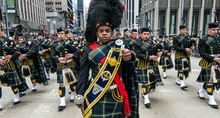
The United States Naval Academy is a federal service academy in Annapolis, Maryland. It was established on 10 October 1845 during the tenure of George Bancroft as Secretary of the Navy. The Naval Academy is the second oldest of the five U.S. service academies and it educates midshipmen for service in the officer corps of the United States Navy and United States Marine Corps. It is part of the Naval University System. The 338-acre (137 ha) campus is located on the former grounds of Fort Severn at the confluence of the Severn River and Chesapeake Bay in Anne Arundel County, 33 miles (53 km) east of Washington, D.C., and 26 miles (42 km) southeast of Baltimore. The entire campus, known colloquially as the Yard, is a National Historic Landmark and home to many historic sites, buildings, and monuments. It replaced Philadelphia Naval Asylum in Philadelphia that had served as the first United States Naval Academy from 1838 to 1845 when the Naval Academy formed in Annapolis.

A pipe band is a musical ensemble consisting of pipers and drummers. The term pipes and drums, used by military pipe bands is also common.

A military band is a group of personnel that performs musical duties for military functions, usually for the armed forces. A typical military band consists mostly of wind and percussion instruments. The conductor of a band commonly bears the title of bandmaster or music director. Ottoman military bands are thought to be the oldest variety of military marching bands in the world, dating from the 13th century.

Beating Retreat is a military ceremony dating to 17th-century England and was first used to recall nearby patrolling units to their castle.

United States military bands include musical ensembles maintained by the United States Army, United States Marine Corps, United States Navy, United States Air Force, and United States Coast Guard. More broadly, they can also include musical ensembles of other federal and state uniformed services, including the Public Health Service and NOAA Corps, the state defense forces, and the senior military colleges.

A military tattoo is a performance of music or display of armed forces in general. The term comes from the early 17th-century Dutch phrase doe den tap toe, a signal sounded by drummers or trumpeters to instruct innkeepers near military garrisons to stop serving beer and for soldiers to return to their barracks and is unrelated to the Tahitian origins of an ink tattoo.

The United States Naval Academy Band was officially founded in November 1852. Previously, there had been a band since the founding of the Naval Academy in 1845, consisting of a fifer and a drummer. The band consists of US Navy career musicians. The band is required to blend tradition and change into a wide variety of musical styles.

The Regimental Pipes and Drums of The Calgary Highlanders is an authorized volunteer pipe band associated with The Calgary Highlanders of the Canadian Forces. For many years, the band was a bona fide, and separate, military unit unto itself, with a separate Unit Identification Code within the CF. Today, the band has been reduced to volunteer status but officially maintains an establishment of eight paid military musicians on its rolls. The band has had mixed success in competitions, but under the direction of Pipe Major Michael Giles had become successful in the Grade Three circuit in Alberta in the years leading up to the regimental centennial in 2010. The band published a recording to commemorate the 80th anniversary of the Regiment in 1990, titled Eighty Years of Glory and commemorated its centennial in 2010 by releasing a second CD entitled Onward.
The Regimental Band and Pipes was founded on the Citadel campus in Charleston, South Carolina, in 1909, with marine general Harry K. Pickett in command. The marching band makes up one of the twenty-one companies of the South Carolina Corps of Cadets. In 1991, the band participated in the Edinburgh Military Tattoo in Scotland, becoming the first military college selected for the honor. They returned in 2010 as the only unit from the United States to appear at the Silver Jubilee of the Tattoo and appeared again in 2015.

The Royal Military College of Canada Bands is the official group of bands of the Royal Military College of Canada. The group is composed of four sections: the brass and reed, the pipes and drums, highland dancers, and choristers. Total band membership consists of 105 Officer Cadets from the college. Officer Cadets in the band practice three days a week in the morning on top of attending their individual full-time university programs.

Canadian military bands are a group of personnel in the Canadian Armed Forces (CAF) that performs musical duties for military functions. Military bands form a part of the Music Branch of the CAF, composed of six full-time professional Regular Force bands, 15 Regular Force voluntary bands, and 53 part-time reserve force bands. Bands of the Music Branch are often badged with the unit or Canadian Forces base insignia that they support.

The Brazilian Marine Pipes, Drum and Bugle Corps is the only field music formation in service in the Brazilian Marine Corps and within the wider Brazilian Navy, and one of a few active formations today in service in the Brazilian Armed Forces. Formed in 1822 on the basis of the field music formations of the present day Portuguese Marine Corps stationed in Brazil, it is also the oldest in South America.

The Indian military bands consists of musicians from the Indian Army, Navy and Air Force. Indian military bands regularly participate in international festivals and take part in celebrations dedicated to various national events. These bands are permanent participants in the Delhi Republic Day parade on the Kartavya Path. Today, the Indian Armed Forces have more than 50 military brass bands and 400 pipe bands and corps of drums. A Tri-Services Band refers to a joint Indian Armed Forces military band that performs together as a unit. At the Spasskaya Tower Military Music Festival and Tattoo in Moscow, the band consisted of 7 officers and 55 musicians. The Military Music Wing of the Army Education Corps is the principal educational institution of the armed forces that provides instruction to musicians of all ranks. Instruction is also provided by the Military Music Training Center and the Indian Navy School of Music.

There are currently 9 main military bands currently belonging to the South African National Defence Force (SANDF), which represent the different branches of the SANDF and providing music on ceremonial occasions. Since military bands were introduced in the country, they have played a prominent role in public and military life. Pipe bands also play an important role in South African military music, with notable pipe bands coming from the Cape Town Highlanders, Transvaal Scottish Regiment and the South African Military Health Service. Military bands of the SANDF are also affiliated with the police bands of the South African Police Service. In addition to military music, military bands in the SANDF perform different genres, including classical, jazz, pop and light music.

The Band of the Ceremonial Guard is an ad hoc military band that is attached to the Canadian Forces Ceremonial Guard in Ottawa. All members of the band are fully trained members of the Canadian Armed Forces (CAF) and consists of personnel principally from the two Foot Guards regiments and has even since 2007 been manned by a pan–Canadian Forces approach that is inclusive to musicians from the Royal Canadian Navy, Canadian Army and Royal Canadian Air Force. The band forms a separate company within the CG and rely on the Headquarters Company for administration and support personnel. In full composition, the band is active from April to August.
The Pipes and Drums of The Cameron Highlanders of Ottawa is an authorized pipe band in the Canadian Forces, attached to of Headquarters and Service Company of The Cameron Highlanders of Ottawa. It provides musical support for regimental and extra-Regimental activities as directed by the commanding officer. Outside of musical duties, the 25-members of the Pipes and Drums participate in Individual Battle Task Standards (IBTS), which requires it to augment "A" Company during field training exercises.

The United States Naval Academy Drum and Bugle Corps is the military band and drum and bugle corps of the United States Naval Academy, which is a federal service academy in the United States Armed Forces based Maryland. Like its counterpart at the Air Force Academy, it is staffed by midshipmen from the Brigade of Midshipmen. It provides support to the brigade as well as the Plebe Summer Regiment. Until the addition of woodwinds in June 2021, it was the oldest continuously active drum and bugle corps in the United States. It currently performs over 70 times per year.

The Marine Corps Musician Enlistment Option Program (MEOP) is the central organized body overseeing the active-duty military bands of the United States Marine Corps. Marine Corps field bands can be found in the Southeast United States, Southern California, and the Pacific-Asia region. While serving with their bands, Marines perform throughout the continental United States and travel internationally to locations ranging from Beijing to Paris. These units take part in activities such as retirement ceremonies, the Marine Corps Birthday Ball, funerals, change of commands, and civil/military parades. It is one of two music programs in the Department of the Navy, with the other being Fleet Band Activities.




















